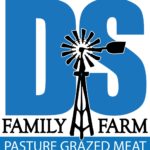Worried about what you are "really" eating? Have peace of mind with pasture grazed meats.
Cow Pie Testing
Viewer discretion advised, cow pies ahead!

We all know cows communicate by mooing. Cows also communicate through their “back-end”. Note the caption under the cow pie photo above. A “healthy looking” cow pie means the cows are healthy! We, I mean Doug, spends a lot of time looking down (at cow pies). A cow pie will tell you how the cows are doing nutritionally.
Want to learn more about how to “read” a cow pie?
Here are two posts from The Samuel Roberts Nobel Foundation (Oklahoma):
- Here’s A New Kind of ‘B.S.’ Degree
- Manure scoring determines supplementation needs (photos included)
Let’s talk quantity
A cow will poop and pee around 4 times every 24 hours. The cow consumes about 3% of her body weight in grass every day. Remember a cow cannot digest grass. That’s around 30 pounds (every day) a cow grazes to feed the microbes living in her special stomach (called the rumen). The trillions of microbes inside of her convert grass into nutrients she can use. It is her job to manage the microbes in her rumen by selecting the best possible diet. It is our job to give her the right size paddock to be able to select the right balance of forages for those little critters inside of her. In the end or should I say OUT the END we gain lots of manure (about 80% what goes in comes out!). Manure is fine when grazing on pasture, not so good for feedlots you drive by with cattle standing around in mud or on dirt.

After taking the photo above I marked out a 2000 square foot area and counted about 70 PIES. That comes to about one pie every 30 square feet. A quick estimate = 1,110 pounds of manure per acre!
Let’s talk quality (nutrient value)
Did you know you can have manure tested? If you are interested in the process, visit the folks at Texas A&M University. The Grazing Animal Nutrition Lab has the corner on the manure testing market with their Nutritional Balance Analyzer (NUTBAL) system (NUTBAL Facebook page). Basically you take a scoop or two from a number of pies, put it in a plastic bag, freeze it and send it to the GANLAB. At the lab, they slip some manure under a near infrared analysis machine and compare it to a database of known results. Using the information they estimate the herds future condition based on a current cow pie test. Based on the results, the herds diet can be adjusted to meet a limiting need such as energy or protein. Let’s just say, sometimes the results don’t quite match what we see in our visual cow pie testing. We are a little bit out of the norm for the database being used.

Total Output
Using the actual manure test results we find reported Nitrogen and Phosphorus values. Running averages on our herd size and also checking against UN-L book values for feedlot manure, following are some estimates for our herd:
- Cow herd was leaving behind ~1100 lbs. of manure per acre
- (Refer to the distribution photo above)
- Nutrient Value of Manure:
- 15-20 lbs. of Nitrogen per acre
- 2 to 4 lbs. of Phosphorus per acre
- Note our Phosphorus value is low compared to UN-L book values
- Urine Nitrogen (N consumed – N found in Manure – N in new animal growth)
- 10-15 lbs of Nitrogen per acre
- It takes 0.04 lbs of Nitrogen for 1 lbs of animal growth
Our overall estimate for Nitrogen per acre = 25 lbs based on our herd management and manure distribution. Reading UN-L information, up to 25% of feed lot manure will be lost to the atmosphere depending on temperature and moisture. For our pasture situation, we think our loss would be lower.
Summary
This post was mainly for Doug’s reference. Thank you to the folks at the GANLAB for their guidance in running some of my calculations. Feel free to scrutinize the estimates here and we will adjust this post as more information becomes available. Our estimates are based on a specific herd size at a specific time and place using field and lab information. To make some rough calculations for any herd size I would start with the following values:
For each 1000 lbs of animals in the herd:
- 0.25 lbs of Nitrogen per day output
- Subtract 0.04 lbs of Nitrogen for every pound of new animal growth per day
- Consider a feed test to check total Nitrogen going into the herd/animal
- Crude protein lbs intake / 6.25 = Nitrogen intake
- Consider a percent loss to atmosphere
- What is the distribution?
- If manure is piling up in a lot, under a tree or next to a water source, we are not recycling nutrients properly.
- We should always be looking at ways to improve animal impact.




